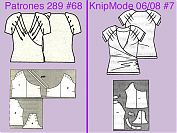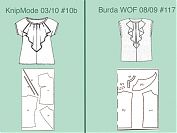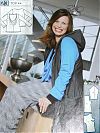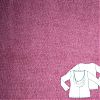Double take!
Fashion has always been cyclical – we reinvent ideas from decades past and give them a new twist. But with everyone playing off similar influences, sometimes two designers independently come up with very similar ideas. So it’s really not a surprise that you can sometimes find very similar pattern designs across companies, too.
As I found out, once you start looking for “pattern twins”, suddenly you start seeing them everywhere!
Patrones vs Knip tops
It all started when reader Hilde pointed out in my Patrones 289 review that this Plus top looks an awful lot like an older KnipMode design, so I decided to investigate further by comparing the shapes of the pattern pieces side-by-side:
(This KnipMode top was previously neglected because it was in the same issue as the fabulous swimsuit pattern…)
While the tech drawings look different, when you look at the pattern pieces you can see that most of that is just down to artistic interpretation and the pieces are very similar indeed!
Knip vs Burda blouses
Then I noticed in my review of the March 2010 KnipMode that their ruffle-collared blouse was incredibly similar to one Burda released last year!





